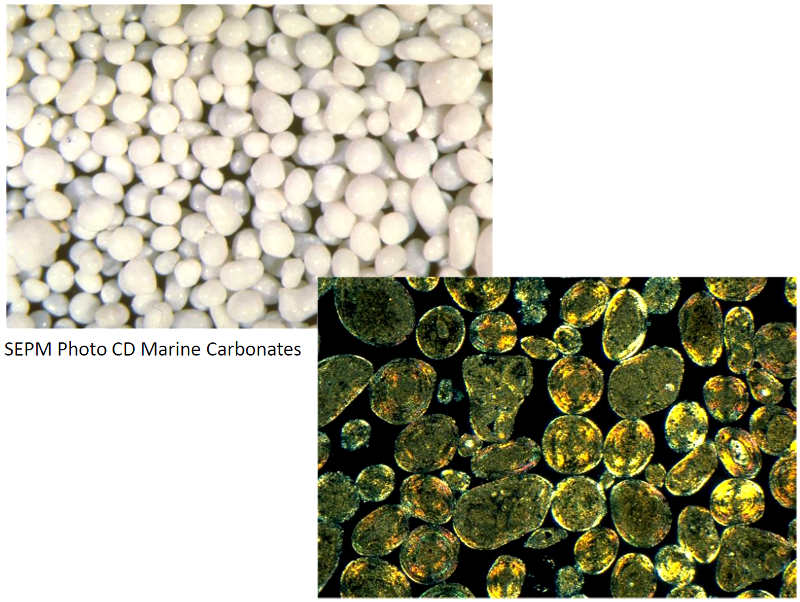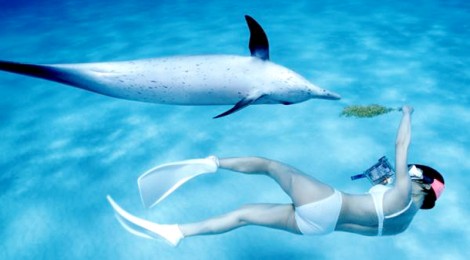
Sahara Dust Produces Massive Bahama Carbon Sink
A great mystery about how CO2 in ocean water is converted into solid carbonates is solved
This explains the formation of vast regions of carbonate geology on the world’s seabeds.
White sands of the Bahamas are grown by iron fertilized micro-plankton
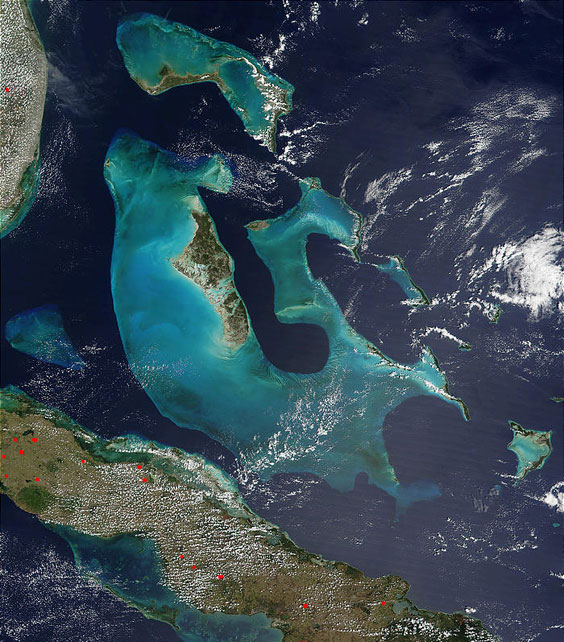
Bahama Bank From Space — A vast store of carbonate rock representing 2 million billion tonnes of CO2 made to sink due to dust in the wind growing phyto-plankton
The authors of a new paper just published in the Journal Geology have spent a lifetime studying the Geology of the Bahama’s, or more properly the vast Great Bahama Bank. That bank is the largest mound of carbonate in the world, more than 100,000 km2 in size and thousands of meters thick. It was built by micro-plankton out of 2 million billion tonnes of CO2.
On top of this great bank are of course the coral-rich sub-tropical islands where the common misperception is that over countless millennia those corals were growing and dying and laying down their skeletons as the island-building process.
This post was inspired by a terrific new and important paper that speaks to the role of Saharan dust, the iron and other mineral micronutrients it carries to the ocean, and how this results in a new explanation of the power and potency of ocean photosynthesis in regulating global CO2. Once again we find that the living ocean is not merely a chemical test tube but rather a complex living ecology. But sometimes the chemistry shines through as well or I should say the bio-chemistry.
In short, the authors show that when Sahara dust arrives in the Bahamas cyano-bacteria, what we used to call blue-green algae, bloom. As they bloom their photosynthesis removes CO2 from the water making the pH locally rise, alleviating ocean acidification. That blooming rise of ocean pH to a slightly more alkaline state results in what the Bahamanian’s have long called “Ocean Whitings” where the ocean becomes white like milk.
The whiting of the ocean is the result of white calcium carbonate precipitating out of solution as a solid mineral which sinks to the seafloor and accumulates in massive amounts. On the sea bed, it looks like tiny pellets. That’s because it’s been reprocessed by marine worms.
.
Dust driven micro-plankton mediated carbonate precipitation is a globally important and endangered carbon sink
The incredible amount of CO2 that sinks out of the ocean-bound into calcium carbonate rock is huge. Given the size of the Bahama bank, the amount of CO2 sequestered in the carbonate rock it is made of is about 2 x e15 tonnes (back of the envelope calculation)! That’s 2,000,000,000,000,000 tonnes — 2 million billion tonnes. Now, of course, it has taken about 100 million years for the Bahamas Bank to build but even so it seems this iron fertilized photosynthetic process is sequestering scores of millions of tonnes of CO2 each year. All depending on vital dust in the wind.
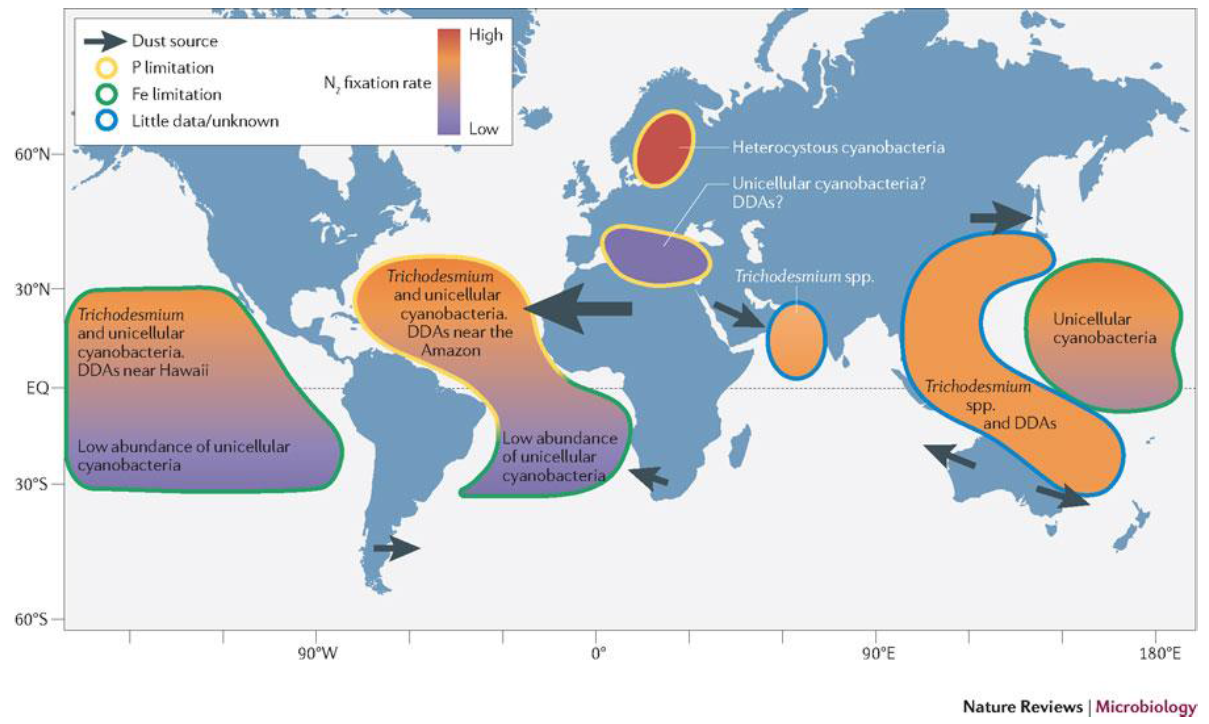
Carbonate precipitating regions of the world’s oceans. Consider that the Bahama Bank is just a fraction of the size of Florida on this map where shallow seas help with the accumulation of carbonates. This process while much studied in the Bahamas is far from unique to that small part of the world. There are vast regions of the world’s oceans where this same process is taking place. Carbonates don’t accumulate much below 4000 meters, but 83% of the world’s oceans are less than 4000 meters in depth so there is plenty of room in the carbonate bank. Curiously in some regions, the carbonate banks contain the richest oil fields on earth.
The dust that blows from land to the oceans proves to have yet another powerful mechanism through which in partnership with ocean pastures and their phytoplankton it works to manage global CO2. This time the cyanobacteria/blue-green algae are stimulated to fix nitrogen which fuels plankton blooms and directly causes the precipitation and sinking of carbonate minerals sending vast quantities of CO2 to the seabed. One unexpected observation in this new paper is that cyano-bacteria need ten times the iron of more ordinary phytoplankton in order to fix nitrogen.
However, dust reaching the oceans and the iron it carries is in dramatic decline!
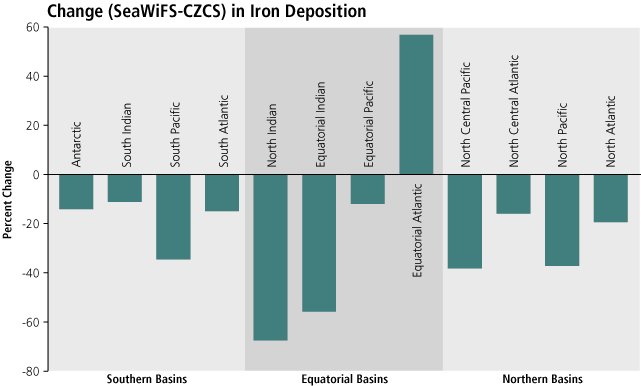
Dust and the iron it deliver is in decline in almost all the world’s ocean basins. It’s up in the Equatorial Atlantic.
There is a dramatic decline in dust and iron in most of the world’s oceans, though not the Equatorial Atlantic, close enough for the Bahamas. As our fossil fuel age is nearing a trillion tonnes of CO2 emissions into the air and oceans this CO2 has produced multiple dire effects and feedback effects.
To make matters worse (from the oceans point of view) our high and rising CO2 improves plant growth on land producing much improved “ground cover” around the world which in turn by covering the ground is preventing dust from blowing out to sea where missing dust and minerals especially iron is the death knell for ocean pastures and their plankton blooms.
Read about the way land and sea, dust and rain in the wind works with the ocean in a Yin and Yang fashion here.
As this paper shows more CO2 in the ocean means dramatically less carbonate precipitation so the CO2 we’ve already emitted and continue to emit is crippling one of Mother Nature’s most potent natural CO2 controls, carbonate sinking in the oceans. But don’t despair.
My Iron Man Solution Is At Hand And It Is Dirt Cheap
The solution to our own and Mother Natures deadly dilemma is of course for us to simply do the right thing. We must and we can restore and revive vital ocean pastures and their phytoplankton by giving back to them the dust we are denying them. This is amazingly effective, immediately deployable, inexpensive, proven in real ocean large scale work, methodology and technology come with the bonus that it begins with the fact that it BRINGS BACK THE FISH, billions of fish to feed our children (feeding the kids, that’s proven too!)
There is a fine write up in FORBES magazine 27 July 2014 about the ironclad proof of CO2 sequestration for geologic time and about my work in this field (see link above.)
><((((º>`·.¸.·´¯`·.¸><((((º>`·.¸.·´¯`·.¸. ><((((º>`·.¸.·´¯`·.¸.><((((º>
Reference: The paper “The fertilization of the Bahamas by Saharan dust: A trigger for the geologic sinking of CO2 via carbonate precipitation?” was published in the Journal Geology June 2014 P.K. Swart, A.M. Oehlert, G.J. Mackenzie, G.P. Eberli and J.J.G. Reijmer Department of Marine Geosciences, Rosenstiel School of Marine and Atmospheric Sciences, University of Miami, Miami, Florida 33149, USA Department of Earth Science, VU University Amsterdam, 1081 HV, Netherlands









